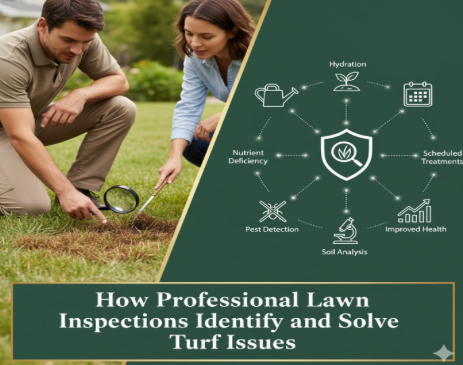A lush, green lawn makes the difference in your home’s exterior, turning your yard into an open-air sanctuary. But no matter how hard you try, your lawn could still have thin spots, weeds encroaching, or look tired instead of vibrant.
Such problems often do not come from overt causes but are concealed in compacted soils, poor drainage, nutrient imbalance, pests, or diseases. That’s why bringing in a full-scale assessment is so valuable — before the situation gets worse.
Whether you’re facing trouble spots or just looking to keep your lawn in top shape, professional lawn inspections can offer many valuable insights that will put you on the road toward better results and peace of mind.
This article will look at how a well-conducted inspection can reveal hidden problems with turf.
-
The Early Warning and Root Cause Identification of the Distress
Healthy lawns do not usually decline overnight. The real warning signs tend to be more subtle: a little thinning here, a slightly dull patch there. And by the time changes in the lawn may become apparent, deeper issues are already at play.
That is why the first step requires proper professional lawn inspections far beyond what is seen on the surface. Inspectors look for those early clues by checking a tree’s soil density, root depth, moisture patterns, and nutrient levels.
The proactive approach is to notice the slight color change, not a full brown spot, or a small moisture imbalance, well in advance, before disease can spread. The early detection of stress, plus an understanding of what is happening beneath the ground, allows remedial action to be taken before damage can take hold, protecting overall health and appearance.
-
Diagnose Soil Compaction, Drainage, and pH Imbalances
The most prevalent issues with turf include poor drainage or soil that is too compacted. The hard soils impede roots from growing down into the deeper levels and taking in moisture and nutrients.
In this regard, a comprehensive lawn inspection includes soil probing, root penetration tests, and water drainage assessment on and off the lawn surface.
They may also check the pH level of the soil or its nutrient content, as most of the grass varieties prefer slightly acidic to neutral soil. Compaction could be addressed by aeration, improving drainage trenches, or enhancing soil structure.
pH usually needs to be adjusted either with lime or sulphur. Without these underlying fixes, high-quality seed or sod may be wasted. By identifying these soil and drainage problems, the inspection lays a sound basis for any subsequent turf improvement work.
-
Weed, Pest, and Disease Pressures Identification
A patchy or discolored lawn is a sign of some sort of biological threat, whether the crowding out of grass by weeds, insects feeding on the roots, or disease attacking the blades themselves.
Now, look for patterns of damage during this inspection phase: Is one side of the yard dominated by a specific type of weed? Are the bare spots in alignment with ant hills or grubs beneath? Are the yellowing areas showing signs of fungal outbreaks?
Knowing the pressure will enable you to select the proper solution-whether it is a selective weed control, a grub treatment, or a fungicide spray-and apply it only where needed.
This saves time and money because it isn’t some blanket treatment; rather, it is targeted. Being able to recognize which particular threat is at work makes all the difference, and that is one big bonus of having the house inspected by an expert.
-
Customize a Strategic Treatment Plan for Your Turf
After the inspection reveals what exactly is going on beneath your lawn’s surface, it is now time to come up with a plan specific to your yard rather than applying “the usual” treatment.
The plan should include when to aerate, where to improve drainage, how to adjust the mowing height and watering schedule, what type of fertilizer suits the grass and soil conditions, and when to apply pest or weed control.
The solutions must, therefore, differ because each lawn is unique, with factors such as shade versus sun, heavy traffic versus light use, and sandy soil versus clay.
A personalized plan enables all the pieces to function in concert, significantly increasing the likelihood of lasting improvement, rather than merely providing quick fixes.
-
Preventive Maintenance to Keep the Improvements Going
It is not enough to simply address pre-existing problems and then walk away; a healthy lawn requires ongoing care to prevent recurring issues.
Equally important as the intervention is the follow-up, which involves regular mowing at the proper height, deep and infrequent watering, repetition of aeration or fertilization, and controlling new outbreaks of weeds or pests at the right time.
This often involves setting a maintenance schedule at the time of this inspection. Regular follow-through with these will maintain the improvements and protect your turf investment.
This will not only give you a good-looking lawn for a few weeks but one that will last through the seasons, provided that proper management practices are implemented.
Final Thoughts
You get so much more than “spray and mow” when you bring in a professional who can assess your yard and conduct a structured series of tests.
Everything plays its part, from soil condition to root health, pest threats to efficient drainage, mowing height to watering patterns.
By relying on a professional lawn inspection at the outset, you can unlock a roadmap to stronger, healthier turf that can withstand the test of time, look great through seasons, and affordably maintain its appearance.
From maintaining a flawless lawn to addressing problem areas, it’s all about being meticulous in one’s inspection and offering tailored treatment. A lawn is the outdoor personality of your home, and it will shine once you get a good start.

